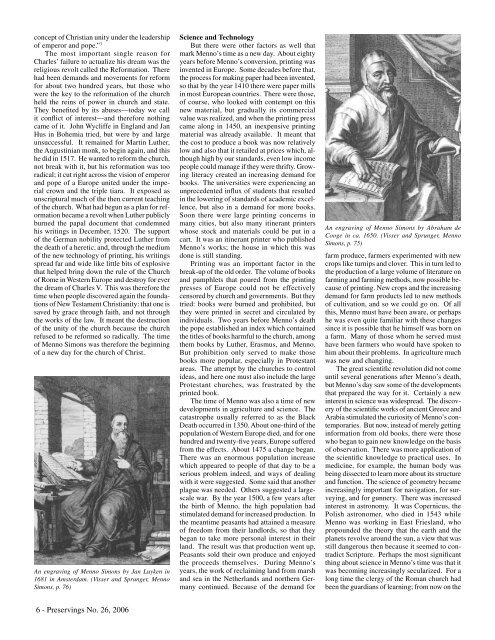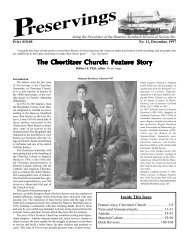Preservings $20 Issue No. 26, 2006 - Home at Plett Foundation
Preservings $20 Issue No. 26, 2006 - Home at Plett Foundation
Preservings $20 Issue No. 26, 2006 - Home at Plett Foundation
You also want an ePaper? Increase the reach of your titles
YUMPU automatically turns print PDFs into web optimized ePapers that Google loves.
concept of Christian unity under the leadership<br />
of emperor and pope.” 3<br />
The most important single reason for<br />
Charles’ failure to actualize his dream was the<br />
religious revolt called the Reform<strong>at</strong>ion. There<br />
had been demands and movements for reform<br />
for about two hundred years, but those who<br />
were the key to the reform<strong>at</strong>ion of the church<br />
held the reins of power in church and st<strong>at</strong>e.<br />
They benefited by its abuses—today we call<br />
it conflict of interest—and therefore nothing<br />
came of it. John Wycliffe in England and Jan<br />
Hus in Bohemia tried, but were by and large<br />
unsuccessful. It remained for Martin Luther,<br />
the Augustinian monk, to begin again, and this<br />
he did in 1517. He wanted to reform the church,<br />
not break with it, but his reform<strong>at</strong>ion was too<br />
radical; it cut right across the vision of emperor<br />
and pope of a Europe united under the imperial<br />
crown and the triple tiara. It exposed as<br />
unscriptural much of the then current teaching<br />
of the church. Wh<strong>at</strong> had begun as a plan for reform<strong>at</strong>ion<br />
became a revolt when Luther publicly<br />
burned the papal document th<strong>at</strong> condemned<br />
his writings in December, 1520. The support<br />
of the German nobility protected Luther from<br />
the de<strong>at</strong>h of a heretic, and, through the medium<br />
of the new technology of printing, his writings<br />
spread far and wide like little bits of explosive<br />
th<strong>at</strong> helped bring down the rule of the Church<br />
of Rome in Western Europe and destroy for ever<br />
the dream of Charles V. This was therefore the<br />
time when people discovered again the found<strong>at</strong>ions<br />
of New Testament Christianity: th<strong>at</strong> one is<br />
saved by grace through faith, and not through<br />
the works of the law. It meant the destruction<br />
of the unity of the church because the church<br />
refused to be reformed so radically. The time<br />
of Menno Simons was therefore the beginning<br />
of a new day for the church of Christ.<br />
An engraving of Menno Simons by Jan Luyken in<br />
1681 in Amsterdam. (Visser and Sprunger, Menno<br />
Simons, p. 76)<br />
Science and Technology<br />
But there were other factors as well th<strong>at</strong><br />
mark Menno’s time as a new day. About eighty<br />
years before Menno’s conversion, printing was<br />
invented in Europe. Some decades before th<strong>at</strong>,<br />
the process for making paper had been invented,<br />
so th<strong>at</strong> by the year 1410 there were paper mills<br />
in most European countries. There were those,<br />
of course, who looked with contempt on this<br />
new m<strong>at</strong>erial, but gradually its commercial<br />
value was realized, and when the printing press<br />
came along in 1450, an inexpensive printing<br />
m<strong>at</strong>erial was already available. It meant th<strong>at</strong><br />
the cost to produce a book was now rel<strong>at</strong>ively<br />
low and also th<strong>at</strong> it retailed <strong>at</strong> prices which, although<br />
high by our standards, even low income<br />
people could manage if they were thrifty. Growing<br />
literacy cre<strong>at</strong>ed an increasing demand for<br />
books. The universities were experiencing an<br />
unprecedented influx of students th<strong>at</strong> resulted<br />
in the lowering of standards of academic excellence,<br />
but also in a demand for more books.<br />
Soon there were large printing concerns in<br />
many cities, but also many itinerant printers<br />
whose stock and m<strong>at</strong>erials could be put in a<br />
cart. It was an itinerant printer who published<br />
Menno’s works; the house in which this was<br />
done is still standing.<br />
Printing was an important factor in the<br />
break-up of the old order. The volume of books<br />
and pamphlets th<strong>at</strong> poured from the printing<br />
presses of Europe could not be effectively<br />
censored by church and governments. But they<br />
tried: books were burned and prohibited, but<br />
they were printed in secret and circul<strong>at</strong>ed by<br />
individuals. Two years before Menno’s de<strong>at</strong>h<br />
the pope established an index which contained<br />
the titles of books harmful to the church, among<br />
them books by Luther, Erasmus, and Menno.<br />
But prohibition only served to make those<br />
books more popular, especially in Protestant<br />
areas. The <strong>at</strong>tempt by the churches to control<br />
ideas, and here one must also include the large<br />
Protestant churches, was frustr<strong>at</strong>ed by the<br />
printed book.<br />
The time of Menno was also a time of new<br />
developments in agriculture and science. The<br />
c<strong>at</strong>astrophe usually referred to as the Black<br />
De<strong>at</strong>h occurred in 1350. About one-third of the<br />
popul<strong>at</strong>ion of Western Europe died, and for one<br />
hundred and twenty-five years, Europe suffered<br />
from the effects. About 1475 a change began.<br />
There was an enormous popul<strong>at</strong>ion increase<br />
which appeared to people of th<strong>at</strong> day to be a<br />
serious problem indeed, and ways of dealing<br />
with it were suggested. Some said th<strong>at</strong> another<br />
plague was needed. Others suggested a largescale<br />
war. By the year 1500, a few years after<br />
the birth of Menno, the high popul<strong>at</strong>ion had<br />
stimul<strong>at</strong>ed demand for increased production. In<br />
the meantime peasants had <strong>at</strong>tained a measure<br />
of freedom from their landlords, so th<strong>at</strong> they<br />
began to take more personal interest in their<br />
land. The result was th<strong>at</strong> production went up.<br />
Peasants sold their own produce and enjoyed<br />
the proceeds themselves. During Menno’s<br />
years, the work of reclaiming land from marsh<br />
and sea in the Netherlands and northern Germany<br />
continued. Because of the demand for<br />
An engraving of Menno Simons by Abraham de<br />
Cooge in ca. 1650. (Visser and Sprunger, Menno<br />
Simons, p. 75)<br />
farm produce, farmers experimented with new<br />
crops like turnips and clover. This in turn led to<br />
the production of a large volume of liter<strong>at</strong>ure on<br />
farming and farming methods, now possible because<br />
of printing. New crops and the increasing<br />
demand for farm products led to new methods<br />
of cultiv<strong>at</strong>ion, and so we could go on. Of all<br />
this, Menno must have been aware, or perhaps<br />
he was even quite familiar with these changes<br />
since it is possible th<strong>at</strong> he himself was born on<br />
a farm. Many of those whom he served must<br />
have been farmers who would have spoken to<br />
him about their problems. In agriculture much<br />
was new and changing.<br />
The gre<strong>at</strong> scientific revolution did not come<br />
until several gener<strong>at</strong>ions after Menno’s de<strong>at</strong>h,<br />
but Menno’s day saw some of the developments<br />
th<strong>at</strong> prepared the way for it. Certainly a new<br />
interest in science was widespread. The discovery<br />
of the scientific works of ancient Greece and<br />
Arabia stimul<strong>at</strong>ed the curiosity of Menno’s contemporaries.<br />
But now, instead of merely getting<br />
inform<strong>at</strong>ion from old books, there were those<br />
who began to gain new knowledge on the basis<br />
of observ<strong>at</strong>ion. There was more applic<strong>at</strong>ion of<br />
the scientific knowledge to practical uses. In<br />
medicine, for example, the human body was<br />
being dissected to learn more about its structure<br />
and function. The science of geometry became<br />
increasingly important for navig<strong>at</strong>ion, for surveying,<br />
and for gunnery. There was increased<br />
interest in astronomy. It was Copernicus, the<br />
Polish astronomer, who died in 1543 while<br />
Menno was working in East Friesland, who<br />
propounded the theory th<strong>at</strong> the earth and the<br />
planets revolve around the sun, a view th<strong>at</strong> was<br />
still dangerous then because it seemed to contradict<br />
Scripture. Perhaps the most significant<br />
thing about science in Menno’s time was th<strong>at</strong> it<br />
was becoming increasingly secularized. For a<br />
long time the clergy of the Roman church had<br />
been the guardians of learning; from now on the<br />
- <strong>Preservings</strong> <strong>No</strong>. <strong>26</strong>, <strong>2006</strong>
















